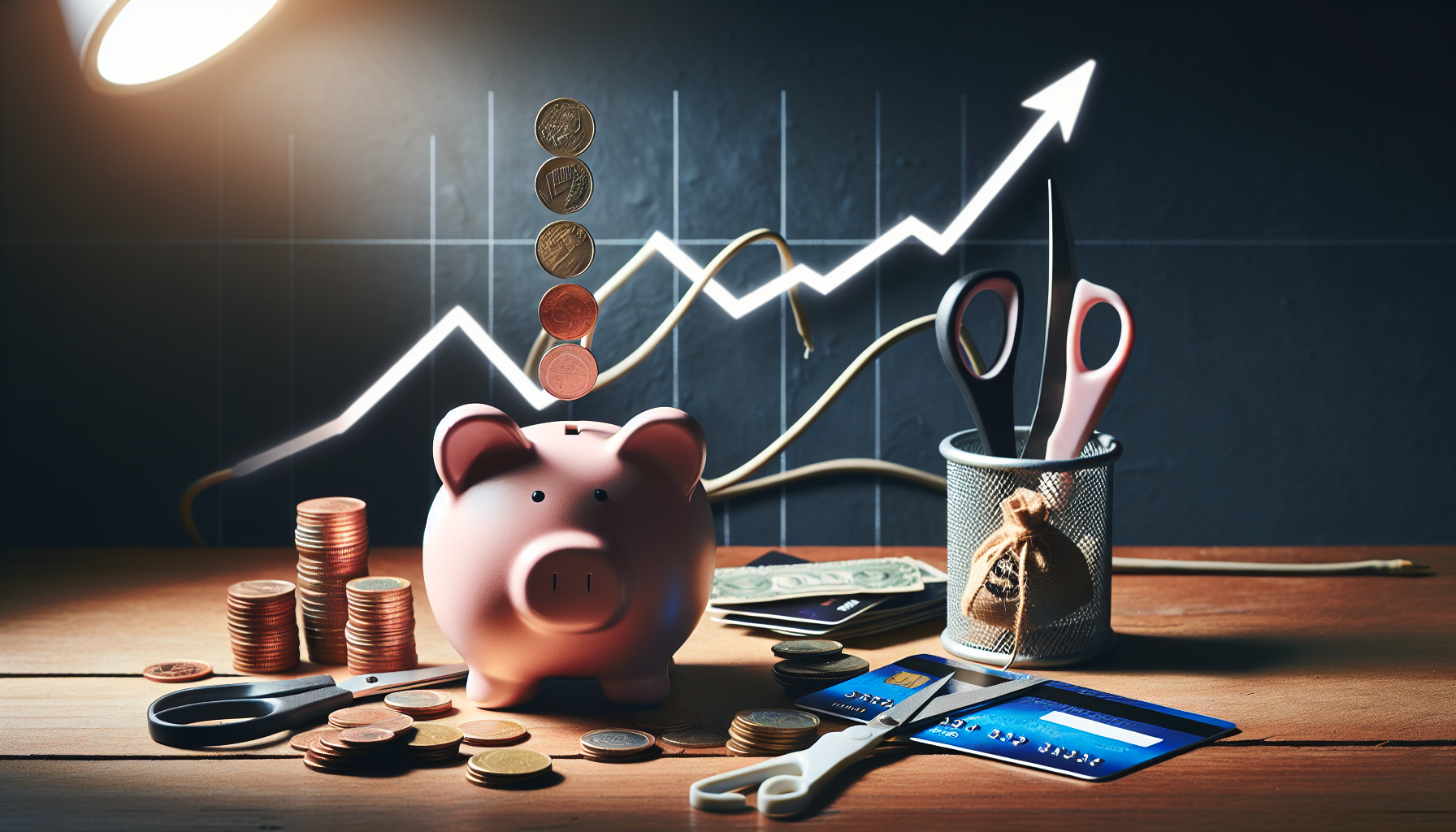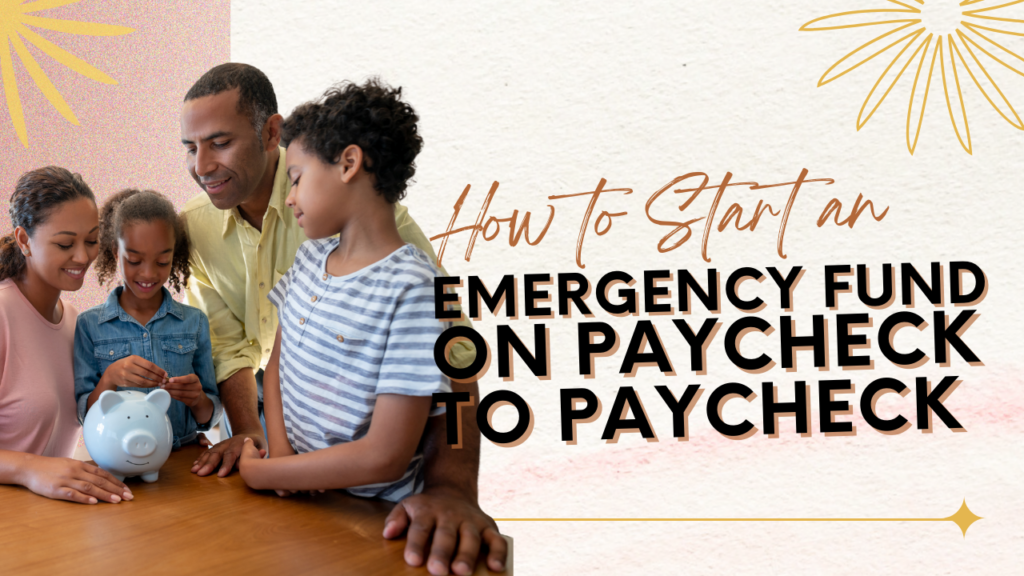If building an emergency fund feels impossible while living paycheck to paycheck, you’re not alone. However, with the right approach, it’s not only possible, it’s practical. This article demystifies “how to start an emergency fund when you are living paycheck to paycheck” on a tight budget, offering actionable steps that can make a significant financial impact without overwhelming you. Get ready to turn your financial stability from a question into a plan, even if it seems like every dollar is already spoken for.
Key Takeaways
- An emergency fund is crucial for financial stability, reducing stress, and avoiding high-interest debt, especially for the 61% of Americans living paycheck to paycheck.
- Creating a realistic budget and tracking expenses are vital first steps in identifying areas for saving and cutting nonessential costs, aiming to enhance financial security.
- To build an emergency fund, cut nonessential expenses, generate additional income, and automate savings, while managing high-interest debt and increasing cash flow to stop living paycheck to paycheck.
Understanding the Importance of an Emergency Fund

Living paycheck to paycheck can leave many people exposed and vulnerable when unexpected financial circumstances arise. An emergency fund is an invaluable safety net, providing a source of money that helps maintain basic living expenses while avoiding the costly repercussions of high-interest debt or credit card payments.
A secure savings account gives individuals financial security in tough times and shields them from getting into unmanageable levels of debt. About 61% percent are unable to save any additional funds outside their necessary wage income for expenses each month without such protection. Having access to this kind of reserve through an emergency fund allows those who live on limited incomes navigate crises with greater peace-of-mind instead of facing potentially crippling debts.
The Role of an Emergency Fund
For far too many, living paycheck to paycheck leaves them at risk of financial disaster when faced with unexpected expenses. An emergency fund is an essential tool for safeguarding your finances and can help break the vicious cycle that 35% of U.S adults find themselves in, credit card debt due to inadequate savings or missing interest payments.
Achieving overall financial well-being depends heavily on having a healthy amount saved up as protection against life’s little surprises. Startlingly, just 61% are managing their funds in this way. Credit cards may seem like an attractive option, but the danger lies in accumulating huge amounts of outstanding debt through significant expenditures which could potentially damage one’s credit score if not paid off quickly enough.
Financial Security and Peace of Mind
Having an emergency fund isn’t just a safeguard of cash, but rather, it grants you assurance and trust. It is that feeling knowing that any unforeseen event can be faced without being pushed into financial hardship. This peace of mind empowers individuals to take control of their personal finances as well as providing evidence for fiscal stability. An emergency fund allows one the ability to concentrate on finding a solution, instead of having thoughts concerned with how they will pay for it clouding up matters. Thus helping in minimizing stress while affirming your financial security!
Assessing Your Current Financial Situation

To establish an emergency fund, it’s important to recognize your financial state. Acknowledging the way money is coming in and going out each month will help you make more suitable monetary decisions while bettering your financial health. This means tracking both income and expenditure closely to identify spending trends with a view to cutting costs and saving cashflow-wise for those living from paycheck to paycheck who are having trouble making ends meet.
Analyzing Income and Expenses
For those with various financial responsibilities, creating a budget and tracking spending are key for analyzing income and expenses. Effective methods of keeping tabs on expenditures include monitoring bank statements, assigning categories to each expense type, as well as utilizing software applications or spreadsheets. A comprehensive personal budget should include all revenues plus outlays such as lodging costs, transportation charges, food expenditure, utilities bills insurance premiums along with both consistent and unpredictable expenses.
Identifying Areas for Improvement
Taking steps to improve your budget is an important aspect of improving financial stability. This could include reducing costs or increasing income, which can be used for saving up emergency funds, thereby providing more security.
A successful budget should have appropriate categories established in order to track expenses properly, as well as software that allows this tracking process and helps keep the budget within its limits. The procedure also needs a calendar set-up with approval rules along with regular reviews so goals are achieved financially.
To get better insight into how money is being spent, it’s best to classify expense items under two main headings. Overhead & production before comparing them against the allocated amounts from their respective budgets, allowing areas where improvement may take place easily visible.
Strategies on How to Start an Emergency Fund

To accumulate funds for an emergency fund, it’s important to look into tactics that can help with this. A budget should be made and followed in order to cut costs on nonessential expenses. Looking at ways of raising your income such as developing hobbies or taking part in the gig economy will allow more money without having a live paycheck-to-paycheck lifestyle.
Automating savings by making contributions directly from salary payments into dedicated accounts for saving is practical so consistent progress towards reaching financial goals can occur while ensuring there are sufficient funds when needed. By setting up automatic transfers between retirement accounts and other sources of pay like take home pay, you’re able to have extra cash available over time while also managing your finances better overall.
Cutting Nonessential Expenses
Knowing where your money goes and keeping track of expenses is key to pinpointing nonessential spending. Establish clear budget boundaries with accounts and precise limits for all expenditures, including discretionary dining out or travel costs as well as personal grooming services. Prioritize purchases according to their impact. Use expense management tools like reviews regularly in order to save an estimated $5,339 annually by cutting down on these kinds of outlays.
Increasing Income
Establishing an emergency fund with additional income is a great way to manage personal finances. A side job can encompass various methods of making money, such as pet or child care services, selling products online and being employed as a taxi driver or food delivery worker, there are many possibilities for creating extra funds through these jobs. According to statistics, in 2022, around 41 percent of U.S. citizens rely on their side hustle to pay day-to-day expenses.
For those looking at earning more by working overtime, the following strategies may be beneficial: assigning workloads effectively, changing staffing plans, investing time into training oneself so they have multiple skill sets available. Setting clear boundaries regarding how much overtime will be done in order not become too overwhelmed financially speaking.
Automating Savings
Creating automated money transfers to a particular emergency fund account makes saving easier and guarantees frequent deposits into your savings. This is an effective technique that aids in accumulating funds for urgent matters by transferring cash automatically from your income to the designated bank account. Automating your finances gives you the chance to save without needing much thought, constructing a financial buffer against crises along with it! You can set up this system through:
- Selecting an appropriate high-interest rate savngs accounts
- Dividing direct deposit between salary payments for parts of each check sent straightway tp yuor savings
- Going online or onto applications on smart phones associated with banking services in order initiate regular autosavings settings
Overcoming Common Obstacles

In order to break the paycheck to paycheck cycle and start creating an emergency fund, it is crucial not to take on any new debt. High-interest payments can severely limit your income stream and inhibit you from putting aside cash for potential emergencies. To quit living on a pay check basis, it’s essential that expenses related with interest be stopped immediately so savings are able to begin growing in both money flow as well as accessible funds.
High Interest Debt
Working to reduce high-interest debt is a key part of reaching financial stability. Credit card payments, which tend to be expensive due to their high interest rates, can quickly accumulate making it difficult for you to save money.
There are several methods that may help manage and minimize these debts, such as the debt avalanche or snowball approach. The avalanche technique concentrates on settling the highest-interest amount first in order to lessen overall costs while paying off all your obligations quicker than normal.
Meanwhile, with using the snow ball method, you start by tackling those lowest balances, then work up from there but ensure minimum payment made on other accounts at all times, so progress continues to be made towards becoming out of debt entirely.
Other tactics like taking advantage of zero percent APR promotion deals available when applying for new credit cards, consolidating loans into one more affordable monthly installment rate or refinancing/replacing current ones could potentially benefit eliminating said higher interest charges.
Limited Cash Flow
To build an emergency fund, having cash flow is essential. Yet there are other options to help increase liquidity, such as renegotiating debt or adjusting one’s expenses. Strategies for cutting monthly outgoings include asking to terminate the service, being knowledgeable of rival rates and promotions, and utilizing a polite yet resolute attitude when negotiating discounts with different providers. Looking into bundling services together, in order to find the most cost-effective solution.
Setting Realistic Goals and Monitoring Progress

Creating an emergency fund starts with establishing achievable objectives and tracking your advancement. Managing finances competently is key to forming practical goals for the emerging fund. To gauge progress, you can set a detailed savings target. Continuously monitor what’s been saved. Compare this amount against your goal in order to be motivated as well as on track along the way.
Determining Your Emergency Fund Target
When setting an emergency fund target, your living expenses should always be taken into account. Financial advisors advise having 3-6 months of those costs saved up in the form of a reserve for emergencies. When considering debt payments it can limit how much money you are able to save aside each month meaning less goes towards building your funds. It’s also essential that income stability is maintained as this ensures you have enough resources for unexpected bills and maintenance costs which would normally come out of the savings pot if they were available at all times.
Celebrating Milestones
When working towards an emergency fund, it is essential to recognize and honor key savings milestones in order to stay motivated. Celebrating each milestone achieved can provide a sense of confidence, show others the benefits of setting financial goals, bolster positive habits while allowing for reward without breaking your budget! Milestones may include saving 3-6 months worth of living expenses or surpassing expected targets. It’s important that you prioritize this goal ahead of expensive purchases during the saving process as well.
Summary
Taking control of finances starts with building an emergency fund, for it provides financial safety and stability. This is achieved by analyzing one’s income and expenses to develop a budget. Money saved can be put towards the emergency savings pot. Creating such a cushion means less stress in times of unexpected costs or major outlays, allowing escape from being tied to regular paychecks alone.
In order to start this process successfully, begin small but consistently work towards adding funds each month – soon enough your hard earned efforts will produce results which you’ll be grateful for when they are needed most! Securing long-term economic security depends on having a good foundation like an established emergency fund that serves as a protective shield against unanticipated bills.
Frequently Asked Questions
How to build an emergency fund when you live paycheck to paycheck?
When living paycheck to paycheck, constructing an emergency fund requires budgeting and finding approaches for reducing money on expenses. To ensure your savings remain consistent, set up programmed transfers from each salary into the dedicated account you’ve established. Not only will this help achieve a monetary backup plan should unexpected situations arise, but it’ll save you money in the long run too!
How do you start a budget when you live paycheck to paycheck?
Making a budget is an effective way to monitor income and outgoings, allowing you to take charge of your finances. Write down all sources of revenue as well as costs in order to keep track of it more effectively.
How do I pay down debt when living paycheck to paycheck?
Managing debt when living paycheck to paycheck is attainable if you are patient and pro-active. Start by monitoring your budget. Then, see how you can increase your income, while also creating an emergency fund so that payments on debts won’t be delayed or skipped over.
How much money do you need to start an emergency fund?
To protect yourself in the event of any potential job loss or other unanticipated alterations to your income, you should consider setting aside an emergency fund that is at least equivalent to 3-6 months’ worth of essential expenses. Choose a figure which feels comfortable for you and tweak it as required.
What is an emergency fund, and why is it important?
An emergency fund is essential for providing security and reassurance in the face of financial uncertainties. This reserve consists of money allocated to take care of any unforeseen expenses that might come up. It’s a helpful tool that ensures you will have enough funds on hand when needed, saving both time and energy during difficult times.




